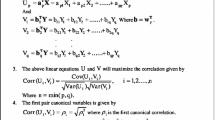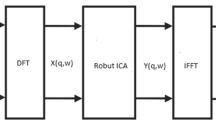Abstract
Blind source separation of complex-valued signals has been a vital issue especially in the field of digital communication signal processing. This paper proposes a novel method based on nonlinear autocorrelation to solve the problem. Relying on the temporal structure with nonlinear autocorrelation of the signals, the method has a potential capability of extracting non-stationary complex sources with Gaussian or non-Gaussian distribution. Most traditional methods would fail in separating this kind of sources. We also analyze the stability conditions of the method in theory. Numerical simulations on artificial complex Gaussian data and orthogonal frequency division multiplexing sources corroborate the validity and efficiency of the proposed method. Moreover, with respect to classical methods, including cumulant-based approach using the non-stationarity of variance and complexity pursuit, our method offers equally good results with lower computational cost and better robustness. Finally, experiments for the separation of real communication signals illustrate that our method has good prospects in real-world applications.








Similar content being viewed by others
References
S. Amari, Natural gradient works efficiently in learning. Neural Comput. 10, 251–276 (1998)
S.I. Amari, A. Cichocki, H. Yang, A new learning algorithm for blind source separation. Adv. Neural Inf. Process. Syst. 8, 757–763 (1996)
A.K. Barros, A. Cichocki, Extraction of specific signals with temporal structure. Neural Comput. 13(9), 1995–2003 (2001)
A. Belouchrani, K.A. Meraim, J.-F. Cardoso, E. Moulines, A blind source separation technique based on second order statistics. IEEE Trans. Signal Process. 45(2), 434–444 (1997)
E. Bingham, A. Hyvarinen, A fast fixed-point algorithm for independent component analysis of complex valued signals. Int. J. Neural Syst. 10, 1–8 (2000)
E. Bingham, A. Hyvarinen, A fast fixed-point algorithm for independent component analysis of complex valued signals. Int. J. Neural Syst. 10, 1–8 (2000)
P. Comon, C. Jutten, Handbook of Blind Source Separation: Independent Component Analysis and Applications (Academic Press, New York, 2010)
A. Cichocki, S.-I. Amari, Adaptive Blind Signal and Image Processing: Learning Algorithms and Applications (Wiley Press, New York, 2002)
J.-F. Cardoso, A. Souloumiac, Blind beamforming for non-Gaussian signals. IEE Proc. F (Communications, Radar and Signal Processing) 140, 362–370 (1993)
J.-F. Cardoso et al., Source separation using higher order moments. Proc. IEEE ICASSP 4, 2109–2112 (1989)
J. Chien, H. Hsieh, Convex divergence ICA for blind source separation. IEEE Trans. Audio Speech Lang. Process. 20(1), 302–313 (2012)
N. Delfosse, P. Loubaton, Adaptive blind separation of independent sources: a deflation approach. Signal Process. 45, 59–83 (1995)
A. Hyvarinen, J. Karhunen, E. Oja, Independent Component Analysis (Wiley Press, New York, 2001)
K.T. Herring, A.V. Mueller, D.H. Staelin, Blind separation of noisy multivariate data using second-order statistics: remote-sensing applications. IEEE Trans. Geosci. Remote Sens. 47(10), 3406–3415 (2009)
A. Hyvarinen, Blind source separation by nonstationarity of variance: a cumulant-based approach. IEEE Trans. Neural Netw. 12(6), 1471–1474 (2001)
S. Henning, Z. Tiziano, W. Laurenz, An extension of slow feature analysis for nonlinear blind source separation. J. Mach. Learn. Res. 15, 921–947 (2014)
A. Hyvarinen, A unifying model for blind separation of independent sources. Signal Process. 85(7), 1419–1427 (2005)
A. Hyvärinen, Complexity pursuit: separating interesting components from time-series. Neural Comput. 13(4), 883–898 (2001)
J. Liu, H. Xu, Y. Wan, On the performance of space-time block coding based on ICA neural networks. Int. Symp. Neural Netw. Dalian 3174, 311–316 (2004)
L. Molgedey, H.G. Schuster, Separation of a mixture of independent signals using time delayed correlations. Phys. Rev. Lett. 72(23), 3634–3637 (1994)
K. Matsuoka, M. Ohya, M. Kawamoto, A neural net for blind separation of nonstationary signals. Neural Netw. 8(3), 411–419 (1995)
M. Novey, T. Adali, On extending the complex fastica algorithm to noncircular sources. IEEE Trans. Signal Process. 56(5), 2148–2154 (2008)
M. Novey, T. Adali, Complex ICA by negentropy maximization. IEEE Trans. Neural Netw. 19(4), 596–609 (2008)
M. Novey, T. Adali, ICA by maximization of non-Gaussianity using complex functions, in Proceedings of the IEEE Workshop Machine Learning for Signal Processing (MLSP), Mystic, CT (2005)
K.B. Petersen, M.S. Pedersen, The Matrix Cookbook. [Online] Cited 2008-11-10. http://www2.imm.dtu.dk/pubdb/p.php?3274
D.-T. Pham, J.-F. Cardoso, Blind separation of instantaneous mixtures of non-stationary sources. IEEE Trans. Signal Process. 49(9), 1837–1848 (2001)
T. Ristaniemi, K. Raju, J. Karhunen, E. Oja, Inter-cell interference cancellation in CDMA array systems by independent component analysis, in Proceedings of the 4th International Symposium on Independent Component Analysis and Blind Signal Separation, pp. 739–744 (2003)
J.V. Stone, Blind source separation using temporal predictability. Neural Comput. 13, 1559–1574 (2001)
Z. Shi, C. Zhang, Fast nonlinear autocorrelation algorithm for source separation. Pattern Recognit. 42(9), 1732–1741 (2009)
Z. Shi, Z. Jiang, F. Zhou, A fixed-point algorithm for blind source separation with nonlinear autocorrelation. J. Comput. Appl. Math. 223, 908–915 (2009)
Z. Shi, H.J. Zhang, Z.G. Jiang, Hybrid linear and nonlinear complexity pursuit for blind source separation. J. Comput. Appl. Math. 236, 3434–3444 (2012)
L. Tong, R.-W. Liu, V. Soon, Y.-F. Huang, Indeterminacy and identifiability of blind identification. IEEE Trans. Circuits Syst. 38(5), 499–509 (1991)
A. Van Den Bos, Complex gradient and Hessian. Proc. Inst. Elect. Eng. Image Signal Process. 141, 380–382 (1994)
J. Wang, C. Zhao, A Semi-blind Detection Algorithm for V-BLAST System (IEEE GLOBECOM, San Francisco, 2003)
H.H. Yang, On-line blind equalization via on-line blind separation. Signal Process. 68(3), 271–281 (1998)
Acknowledgments
This work was supported by the National Natural Science Foundation of China under Grant Nos. 61172061 and 61201242 and the Natural Science Foundation of JiangSu Province in China under Grant No. BK2012057.
Author information
Authors and Affiliations
Corresponding author
Appendices
Appendix 1
1.1 Proof of \(\arg \left( {\beta _1^*} \right) =-\theta \) in (14)
By the definition of \(\beta _1 =\frac{\partial J(\mathbf{q}_1 )}{\partial q_1^*}\), we can obtain
According to the approximation of \(\hbox {G}(\cdot \)) in Theorem, we have
We multiply \(\beta _{1}\) by \(e^{-j\theta }\) and define \(h_1 =e^{-j\theta }s_1, h_2 =e^{j\theta }s_{1,\tau _k }^*\), then
Therefore, we can observe that \(e^{-j\theta }\beta _{1}\) is actually real-valued number, which completely proves \(\arg \left( {\beta _1^*} \right) =-\theta \).
Appendix 2
1.1 Proof of Lemma 1
Since \(a_j =\frac{\partial ^{2}J(\mathbf{q}_i )}{\partial q_j^*\partial q_j }\) (\(\forall j\ne i)\), where \(J(\mathbf{q}_{i})\) denotes the cost function \(J(\mathbf{q})=\sum \limits _k {\left| {E\left\{ {G\left( {y(t)} \right) G(y(t-\tau _k )^{*})} \right\} } \right| ^{2}} \) at the stable point \(\mathbf{q}_i =(0,\ldots , e^{j\theta },\ldots , 0)^{T}\) pointing in the direction of the principal components of \(s_{i}\), we can obtain
Careful inspection reveals that the second-order derivative \(a_j \) is also real-valued number. Taking into account the assumption of Lemma 1 and the zero mean assumption of the source signals, we can get \(a_j =0\). Therefore, from the Theorem, we have the further stability condition: \(\left| {\frac{\partial J(\mathbf{q}_i )}{\partial q_i^*}} \right| -\left| {\frac{\partial ^{2}J(\mathbf{q}_i )}{\partial q_j^*\partial q_j^*}} \right| >0\).
1.2 Proof of Lemma 2
From the definition of \(b_j =\frac{\partial ^{2}J(\mathbf{q}_i )}{\partial q_j^*\partial q_j^*}\) (\(\forall j\ne i)\) and the assumptions of Lemma 1, we have
where \(\hbox {g}^{\prime }(\cdot )\) is the derivative of \(\hbox {g}(\cdot \)). As we know, if sources \(\left\{ {s_j } \right\} \) are circular (rotation invariant), the pseudo-covariance \(E\left\{ {s_j^2 } \right\} =0\), which means that \(b_j =0\). Hence, the stability conditions are given by \(\left| {\frac{\partial J(\mathbf{q}_i )}{\partial q_i^*}} \right| \ne 0\) for circular sources and \(\left| {\frac{\partial J(\mathbf{q}_i )}{\partial q_i^*}} \right| -\left| {\frac{\partial ^{2}J(\mathbf{q}_i )}{\partial q_j^*\partial q_j^*}} \right| >0\) for non-circular sources (\(E\left\{ {s_j^2 } \right\} \ne 0)\).
Rights and permissions
About this article
Cite this article
Xu, P., Shen, Y., Jian, W. et al. Maximization of Nonlinear Autocorrelation for Blind Source Separation of Non-stationary Complex Signals. Circuits Syst Signal Process 34, 3011–3029 (2015). https://doi.org/10.1007/s00034-015-9998-3
Received:
Revised:
Accepted:
Published:
Issue Date:
DOI: https://doi.org/10.1007/s00034-015-9998-3




